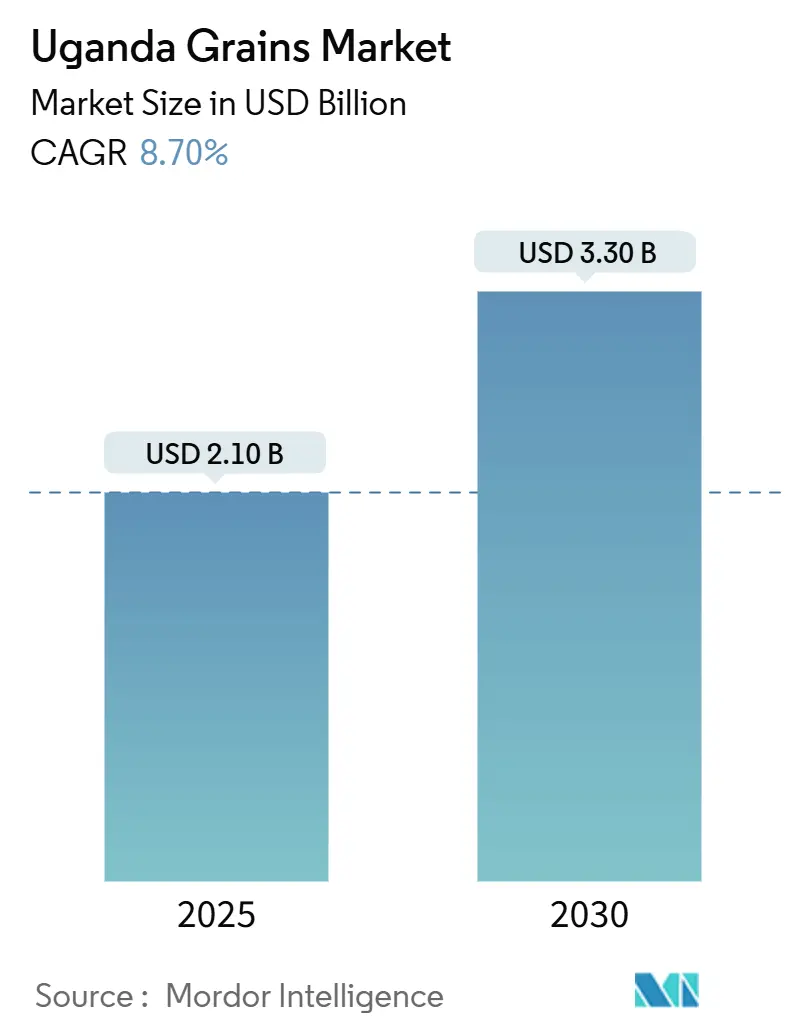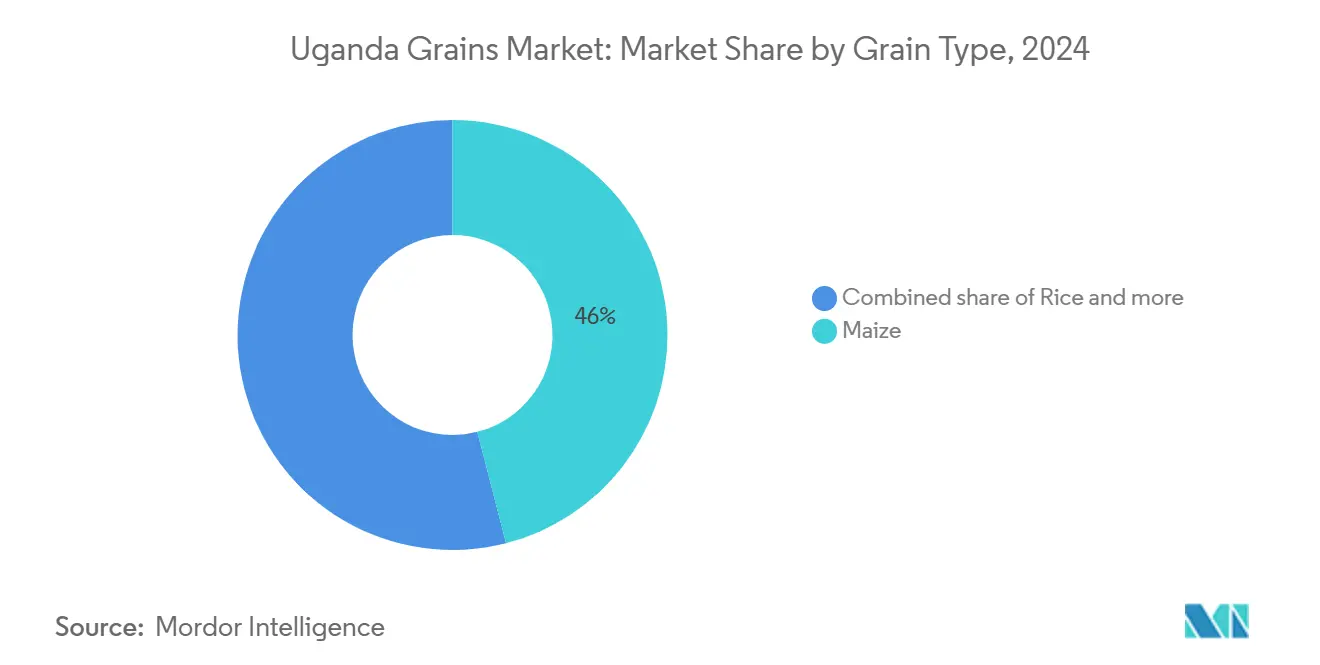
Uganda Grains Market Analysis by Mordor Intelligence
The Uganda grains market size stands at USD 2.10 billion in 2025 and is projected to reach USD 3.30 billion by 2030, expanding at an 8.70% CAGR over the forecast period. Robust government investments in farm inputs, expanding cross-border trade volumes, and steady uptake of digital produce exchanges underpin this trajectory. Maize remains the pivotal staple, while drought-resistant varieties and fertilizer subsidies lift yields and mitigate climate risk. Private operators deploy certified silos and warehouse-receipt systems that reduce post-harvest losses and unlock affordable finance, creating fresh revenue pools for service providers. At the same time, mobile money–enabled trading apps improve price discovery and shorten cash conversion cycles for smallholder suppliers. Collectively, these trends pull Uganda closer to its ambition of becoming the East African grain corridor that satisfies growing animal-feed and food-processing demand in Kenya, the Democratic Republic of Congo, and South Sudan.
Key Report Takeaways
- By grain type, maize led with 46% of the Uganda grains market share in 2024, and rice is projected to grow at an 8.7% CAGR through 2030.
Uganda Grains Market Trends and Insights
Drivers Impact Analysis
| Driver | (~) % Impact on CAGR Forecast | Geographic Relevance | Impact Timeline |
|---|---|---|---|
| Surge in regional demand for animal feed maize | + 1.8% | Uganda, Kenya, Tanzania, DRC | Medium term (2-4 years) |
| Government fertilizer subsidy roll | + 1.2% | National, with focus on Northern and Eastern regions | Medium term (2-4 years) |
| Expansion of warehouse-receipt system financing | + 0.8% | National, with pilot programs in Central and Eastern regions | Long term (≥ 4 years) |
| Emergence of digital produce exchanges | + 0.6% | National, with higher adoption in Central and Western regions | Short term (≤ 2 years) |
| Regional drought-resistant seed adoption | + 0.5% | Northern Uganda, with spillover to Eastern regions | Long term (≥ 4 years) |
| Entry of private silo operators improving post-harvest quality | + 0.4% | Central and Eastern Uganda near transport corridors | Medium term (2-4 years) |
| Source: Mordor Intelligence | |||
Surge in Regional Demand for Animal Feed Maize
Regional livestock sector expansion drives unprecedented demand for feed-grade maize in Uganda, with Uganda positioned as a primary supplier to Kenya's poultry industry and Tanzania's emerging dairy sector. Feed millers increasingly source directly from Ugandan producers, bypassing traditional commodity exchanges to secure consistent supply volumes. This trend accelerates as regional governments prioritize livestock sector development under their respective agricultural transformation programs. The UgandaFertilizer Financing Mechanism's USD 2 million guarantee facility for 60,000 metric tons of fertilizer imports directly supports maize production expansion to meet this growing feed demand [1]Source: World Bank, “Africa Fertilizer Financing Mechanism,” worldbank.org. .
Government Fertilizer Subsidy Roll
Uganda's Parliament allocated significant resources within the UGX 72.1 trillion (USD 20.4 trillion) budget for fiscal year 2024/2025 to support agricultural input subsidies, marking a strategic shift toward productivity-focused farming systems [2]Source: Parliament of Uganda, “Budget Speech FY 2024/2025,” parliament.go.ug. The program targets smallholder farmers with subsidized fertilizer access, complemented by district-level soil testing laboratories to optimize nutrient application. Early implementation phases focus on Northern and Eastern regions where soil fertility constraints limit grain yields. The initiative aligns with the National Development Plan III objectives and leverages partnerships with international fertilizer suppliers to ensure consistent supply chains.
Expansion of Warehouse-Receipt System Financing
The World Bank-supported warehouse receipt system transforms grain marketing by providing farmers with collateral-backed financing options and reducing post-harvest price volatility. Uganda exchange operates digital platforms that connect farmers directly with buyers, eliminating intermediary margins and improving price transparency. Financial institutions increasingly accept warehouse receipts as loan collateral, expanding rural credit access for agricultural investments. The system's expansion requires substantial infrastructure development, with private operators investing in certified storage facilities that meet international quality standards.
Emergence of Digital Produce Exchanges
Digital agriculture platforms revolutionize grain marketing through mobile-based price discovery and transaction facilitation, with EzyAgric scaling to over 300,000 registered farmers by 2024. The platform's partnerships with K+S fertilizer company and MFS (Mobile Financial Services) Uganda payment systems create integrated value chains that reduce transaction costs and improve market access for smallholder producers. Mobile money integration enables instant payments, addressing traditional cash flow constraints in rural grain markets. These platforms generate valuable market intelligence that informs production planning and inventory management decisions across the value chain.
Restraints Impact Analysis
| Restraint | (~) % Impact on CAGR Forecast | Geographic Relevance | Impact Timeline |
|---|---|---|---|
| Post-harvest loss rates | -1.5% | National, with highest losses in Northern and Eastern regions | Short term (≤ 2 years) |
| Informal cross-border trade distorting domestic prices | -0.8% | Border regions with Kenya, DRC, South Sudan, Tanzania | Medium term (2-4 years) |
| Limited cold-chain infrastructure for fresh grains | -0.6% | National, with acute shortages in rural areas | Long term (≥ 4 years) |
| High aflatoxin contamination rejection rates | -0.4% | Central and Eastern regions with high humidity | Medium term (2-4 years) |
| Source: Mordor Intelligence | |||
Post-Harvest Loss Rates
Inadequate storage infrastructure causes grain losses exceeding 20% annually, representing approximately USD 420 million in economic value destruction based on the current market size in 2023. Traditional storage methods using polypropylene bags and metal silos lack moisture control and pest management capabilities, leading to quality deterioration during extended storage periods. The World Food Programme's hermetic storage technology pilot programs demonstrate 90% loss reduction potential, but adoption remains limited by high upfront costs and limited technical support [3]Source: World Food Programme Uganda, “Hermetic Storage Pilot,” wfp.org.. Rural areas particularly suffer from storage infrastructure deficits, forcing farmers to sell immediately after harvest when prices typically reach seasonal lows. Investment requirements for modern storage facilities create barriers for smallholder farmers who produce the majority of Uganda's grain output.
Informal Cross-Border Trade Distorting Domestic Prices
Extensive informal trade flows across Uganda's borders with Kenya, the Democratic Republic of Congo, South Sudan, and Tanzania create price distortions that undermine formal market development and government revenue collection. The West Nile region serves as a major smuggling hub where traders exploit price differentials and avoid customs duties, creating unfair competition for legitimate businesses. These informal channels often bypass quality standards and food safety regulations, potentially compromising consumer protection and export market access. The informal trade networks, while providing market access for remote producers, reduce incentives for investment in formal value chain infrastructure and quality improvement systems.
Segment Analysis
By Grain Type: Maize Leads While Rice Accelerates
Maize commands the largest market share at 46% in 2024, driven by its dual role as a food staple and animal feed ingredient in Uganda expanding livestock sector. The segment benefits from Uganda's competitive production costs and strategic location for serving regional markets, with informal cross-border exports to Kenya contributing to 19% price declines in Kenyan markets during 2024. The Uganda National Bureau of Standards provides quality frameworks that support market development across all grain types, though implementation varies by segment and geographic region.,
Rice emerges as the fastest-growing segment with 8.7% CAGR through 2030, supported by government import substitution policies and expanding processing infrastructure investments by companies like Kibimba Rice and Tilda Uganda. Millet and sorghum maintain smaller but stable market positions, benefiting from growing health consciousness and traditional food preferences, particularly in Northern Uganda where these crops demonstrate superior drought tolerance.

Note: Segment shares of all individual segments available upon report purchase
Geography Analysis
Uganda's position as a landlocked East African nation creates unique market dynamics where domestic grain production serves both local consumption and regional export opportunities. The country's extensive arable land base of around 80% of total territory, with only 35% currently under cultivation, provides substantial expansion potential for grain production. Regional trade flows demonstrate Uganda's integration into East African markets, with maize exports to Kenya, the Democratic Republic of Congo, and South Sudan creating price linkages across borders. The West Nile region functions as a major cross-border trading hub, while the Central and Eastern regions concentrate on processing and storage infrastructure investments.
Cross-border infrastructure development enhances market access, with the Lwakhakha border upgrade to One Stop Border Post status facilitating trade with Kenya, while Lake Victoria freight services using the M.V. Mpungu vessel provide alternative transport routes for grain shipments. Government budget allocations of UGX 5.1 trillion (USD 14.4 trillion) for transport infrastructure within the fiscal year 2024/2025 budget support continued connectivity improvements.
The regulatory environment reflects Uganda Community harmonization efforts, with the Uganda National Bureau of Standards implementing quality frameworks that align with regional standards and facilitate cross-border trade. Pre-Export Verification of Conformity programs operated by SGS ensure compliance with technical regulations and standards, reducing trade barriers and customs delay. Informal trade networks continue to operate alongside formal channels, creating parallel market structures that affect price discovery and revenue collection.
Recent Industry Developments
- April 2025: Bureau Veritas Uganda achieved GAFTA (Grain and Feed Trade Association) accreditation, enhancing the country's capacity for international grain quality certification and export market access. This development strengthens Uganda's position in global grain trade by providing internationally recognized testing and certification services that meet buyer requirements in premium markets.
- November 2024: Export Trading Group secured a USD 394 million loan facility from FMO (Dutch Development Bank) and Trade and Development Bank to expand agricultural operations across Africa, including significant investments in Uganda's grain value chains. The financing enables ETG to enhance storage infrastructure, improve farmer support services, and expand market reach across its 44-country operational network.
- August 2022: The Eastern Africa Grain Council (EAGC) has confirmed that the quality of maize in Uganda has improved by bringing farmers, traders, and processors together to fight against the prevalence of aflatoxin, which can be attributed to increased training of farmers, traders, and processors on post-harvest management and storage practices by the government and private sector players.
Uganda Grains Market Report Scope
Agriculture is one of the most critical sectors of the Ugandan economy. A grain is a small, hard, dry fruit with or without an attached hull layer and is harvested for human or animal consumption. The Uganda Grains Market is segmented by Type (Maize, Millet, Rice, and Sorghum). The report includes the Production Analysis (Volume), Consumption Analysis (Value and Volume), Export Analysis (Value and Volume), Import Analysis (Value and Volume), and Price Trend Analysis of each grain mentioned. The report offers the market size and forecasts in terms of both volume in metric tons and value in USD thousand for all the above segments.
| Maize |
| Millet |
| Sorghum |
| Rice |
| By Grain Type (Production Analysis (Volume), Consumption Analysis (Volume and Value), Import Analysis (Volume and Value), Export Analysis (Volume and Value), and Price Trend Analysis) | Maize |
| Millet | |
| Sorghum | |
| Rice |
Key Questions Answered in the Report
What is the current value of the Uganda grains market?
The Uganda grains market size is valued at USD 2.10 billion in 2025.
How fast is the market projected to grow?
It is forecast to reach USD 3.00 billion by 2030, reflecting a 8.7% CAGR.
Which grain holds the largest share?
Maize leads with 46% of the Uganda grains market share in 2024.
Which grain is growing the fastest?
Rice posts the highest growth, expanding at an 8.7% CAGR through 2030.
What are the main factors driving growth?
Government input subsidies, regional animal-feed demand, warehouse-receipt finance and digital produce exchanges are key drivers.
Page last updated on:

